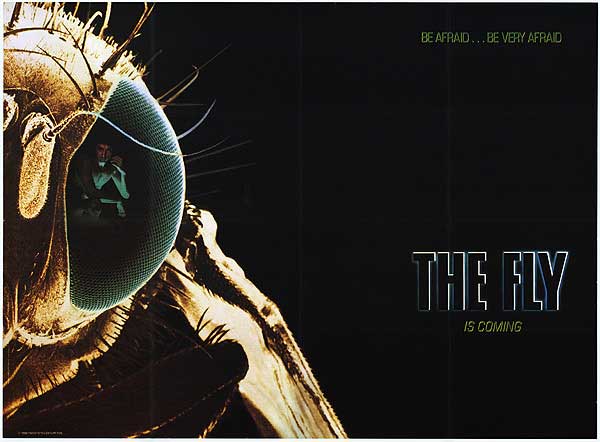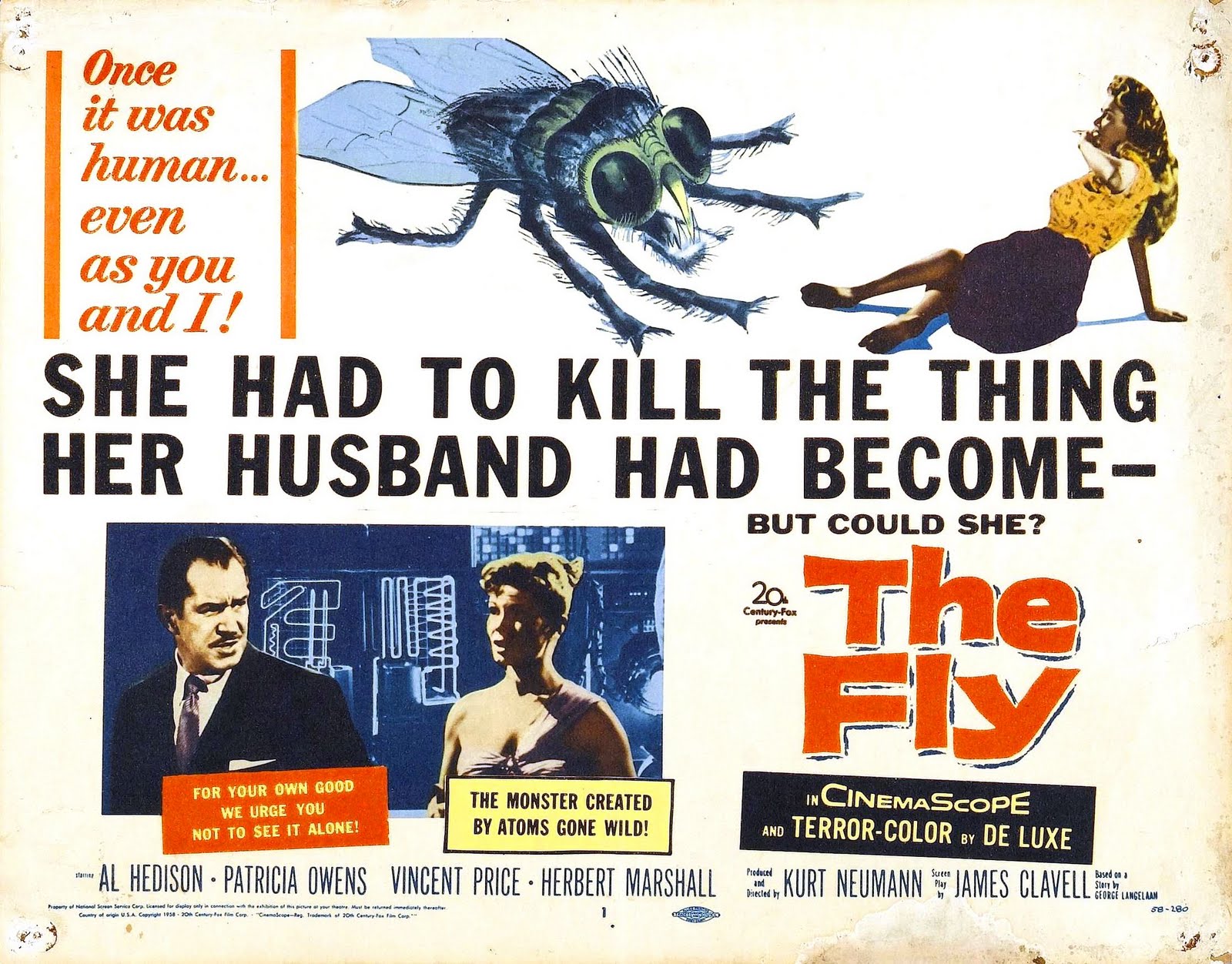
31+ Days of Horror. 33 Horror Movies. 33 Reviews. Hooptober Challenges and Bonus Tasks.
View my 2016 Cinema Shame/Hoop-Tober Watch Pile Shame-a-thon Statement here.
Nature of Shame:
Never seen THE FLY (1986). CAN YOU BELIEVE IT?! Jeff Goldblum. Cronenberg. Oozy goo. THE FLY!
Hoop-tober Challenge Checklist:
Decade – 1980’s
Original and Remake
The Advance Word: OMFG LIKE THE BEST F’ING MOVIE EVER. I’m substituting hyperbole for an honest appraisal of my expectations here. I do so because I scanned the @Letterboxd reviews and that’s pretty much what they said. Allow some wiggle room for paraphrasing.
#13. The Fly (1986)
I feel cheated out of a review because I literally just wrote a review about The Fly. Okay, so that was the 1958 version, but I could copy and paste some of that review into this space and nobody would notice because: #1. You likely didn’t read that review anyway, so it’d be new to you. I’m under no delusions that anyone’s reading all these and #2. Many of the same thoughts apply. Check back in with me when I hit review #20 and I guarantee you’ll just see cribbed bits of all sorts of old thoughts. Maybe just some emoticons and stick figures.
In my writeup for The Fly (1958) I suggested that the film wasn’t so much a horror film as it was a domestic melodrama. A glossy color-saturated Douglas Sirk special, except with a man-fly and a fly-man clouding the homely drama. David Cronenberg, while updating The Fly for 1986 has carried over some melodrama, not so much the DeLuxe Color. He does, however, wrap the melodrama up in a far more unsettling monster movie. Stay tuned for oozy goo, partially-digested bloody stumps, amazing practical creature effects and an even more affecting human narrative.
I don’t mean to suggest that The Fly (1958) lacked a human center. Poor Patricia Owens suffered plenty, but because of the film’s melodramatic artificiality I felt more disconnected from the drama. I observed and studied The Fly (1958) from a greater emotional distance. Cronenberg’s The Fly (1986) grabbed me by the shirt collar, shoved my head in the fly excrement and said “sniff it.” It’s gross, but whatever. There’s a ton of gross stuff in The Fly. Super cool, gross stuff…

The core story remains in tact. A scientist with dreams of matter transportation participates in the scientific method and shatters the life of the woman who loves him. The major narrative shift takes place in the nature of the relationship between scientist and woman. In 1958, the couple lived in wedded bliss before the ill-fated experiment. In 1986, David Cronenberg makes his Fly movie about new love. Jeff Goldblum’s Seth Brundle meets Geena Davis’ journalist at an industry party and brings her back to his place to “show off his experiments.” To him, this means sex. To her, this means she’s supposed to write about his experiments. Yadda yadda yadda he turns a baboon inside out and impregnates her with Brundlefly sperm.
But let’s rewind for a minute.
The Fly (1986) changes the nature of the human/fly transformation. Rather than an immediate change into Hedison-Head Fly and Fly-Head Hedison, Seth Brundle gradually turns into one “Brundlefly.” I suggested that the immediate change and desperate search for the Hedison-Head Fly mirrored the diagnosis of a terminal illness and the subsequent struggle for acceptance. Seth’s gradual metamorphosis (the process of metamorphism is also suggested by the cocoon-like pods that Brundle uses for his transference) from confident human, to superfly human to grotesque monster seems more like the emotional rollercoaster of new love. The journey from flirtation to new love to ghastly, horrible fly monster, aka the cessation of love/romance as brought about by the real world drama that tears people apart.

You can lump terminal illness into that morass of metaphor as well, should you so desire. I’m focusing on how/why Cronenberg shifted the dramatic center. Certainly, the 1950’s would have foregrounded the significance of love/marriage versus the casual sex and far more liberal cinematic norms of the 1980’s. But even this isn’t quite enough to write off the subtext Cronenberg aimed to hammer home.
New love comes with certain passions. This allowed the Goldblum/Davis coupling to amplify the heat and all-consuming passions. But what happens when that love goes sour? What happens when the all-consuming passions fade away and you must face the real human? I think Cronenberg created this monster movie as a way to explore obsession. The violent spark of love and sex, and ultimately the monsters beneath.
Like this guy:

The monstrous elements of The Fly (1986) obscure the fact that the film retains the same female-oriented focus. By employing pregnancy and abortion as a dramatic element, Cronenberg also shifts the focus away from the “mad scientist” angle. As Seth becomes consumed by the fly DNA, he remains a tragic figure, just like Hedison in 1958. Hedison, however, retained his humanity despite a fly head an appendage. When Seth gives way to the Brundlefly, there’s very little left of the man or his compassion. The Brundlefly becomes driven by the need to improve his shattered DNA. The horrors become imposed solely on Davis’ journalist. She must fight off his attempts to merge with her DNA. She must come to terms with the unwanted Brundlefly baby inside her. (That maggot birth scene hallucinion!)
That makes Cronenberg’s The Fly… a woman’s film, too? Indeed, sirs and madams. It’s just a woman’s film wrapped inside a killer monster flick. Neumann’s 1958 The Fly snuck a monster film inside overt melodrama. Two sides of the same coin. Both films offer unique cinematic pleasures of discovery and quirks of narrative focus. Unique approaches to the monster movie tropes. Watching the films back to back, revealed many ways in which the films inform interpretations of each other.
Give it a try. Note the specific changes Cronenberg makes. Having The Fly (1986) as a companion piece to The Fly (1958) shifted the way I viewed the original. There’s a thesis to write here. Others have probably done so. I’m not in the thesis writing business; I’m in the 31 Days of Horror writing business. And business is booming.
Final Thoughts:
Even though I have a 5-star graphic (or more accurately a 5-Hz graphic), I don’t give them out. Silly, huh? To me a 5-Hz rating is only earned over time, tested and proven with multiple rewatches. Since this is my first viewing of The Fly (1986) consider this 4 1/2-Hz rating my highest recommendation. The Fly (1986) is Cronenberg’s masterpiece. I agree with all the Internet hyperbole. An accessible monstrosity featuring top-notch creature effects, a perfect amount of oozy-goo and depth of character and real humanity. Also Jeff Goldblum wearing a baboon.

30Hz Movie Rating:

 Blu-ray Verdict: I wasn’t overly impressed with the transfer on this Blu-ray, but I watched this immediately after being blown away by the quality of The Fly (1958). The blacks lacked depth in certain scenes. That said, the extras on this Fox release more than make up for an average technical presentation.
Blu-ray Verdict: I wasn’t overly impressed with the transfer on this Blu-ray, but I watched this immediately after being blown away by the quality of The Fly (1958). The blacks lacked depth in certain scenes. That said, the extras on this Fox release more than make up for an average technical presentation.
Availability: The Fly (1986) is available on Amazon for a bargain basement price.
Earlier 2016 31 Days of Horror entries: #1. Vampyros Lesbos / #2. A Chinese Ghost Story / #3. The Haunting of Morella / #4. Delirium (1972) / #5. A Lizard in a Woman’s Skin / #6. She-Wolf of London / #7. Son of Frankenstein / #8. Killerfish / #9. The Bride of Re-Animator / #10. A Bay of Blood / #11. The Seventh Victim / #12. The Fly (1958)











 DVD Verdict: Filmed in DeLuxe Color and CinemaScope, The Fly (1958) looks nearly pristine. I noticed no film blemishes. The transfer respects both the grays and blacks of the muted color sequences and the bright, vivid colors noted above. Grain has been maintained. 20th Century Fox generally does a solid job with their catalog titles. I wish they’d do more.
DVD Verdict: Filmed in DeLuxe Color and CinemaScope, The Fly (1958) looks nearly pristine. I noticed no film blemishes. The transfer respects both the grays and blacks of the muted color sequences and the bright, vivid colors noted above. Grain has been maintained. 20th Century Fox generally does a solid job with their catalog titles. I wish they’d do more.




 DVD Verdict: I love this box set, but I never bothered to watch The Seventh Victim on disc so technically I can’t vouch for the quality of transfer contained within. I do like big box sets with lots of DVDs. Some day when I’m old, crazy and senile I hope to bathe in them. That day might be sooner than anticipated.
DVD Verdict: I love this box set, but I never bothered to watch The Seventh Victim on disc so technically I can’t vouch for the quality of transfer contained within. I do like big box sets with lots of DVDs. Some day when I’m old, crazy and senile I hope to bathe in them. That day might be sooner than anticipated.